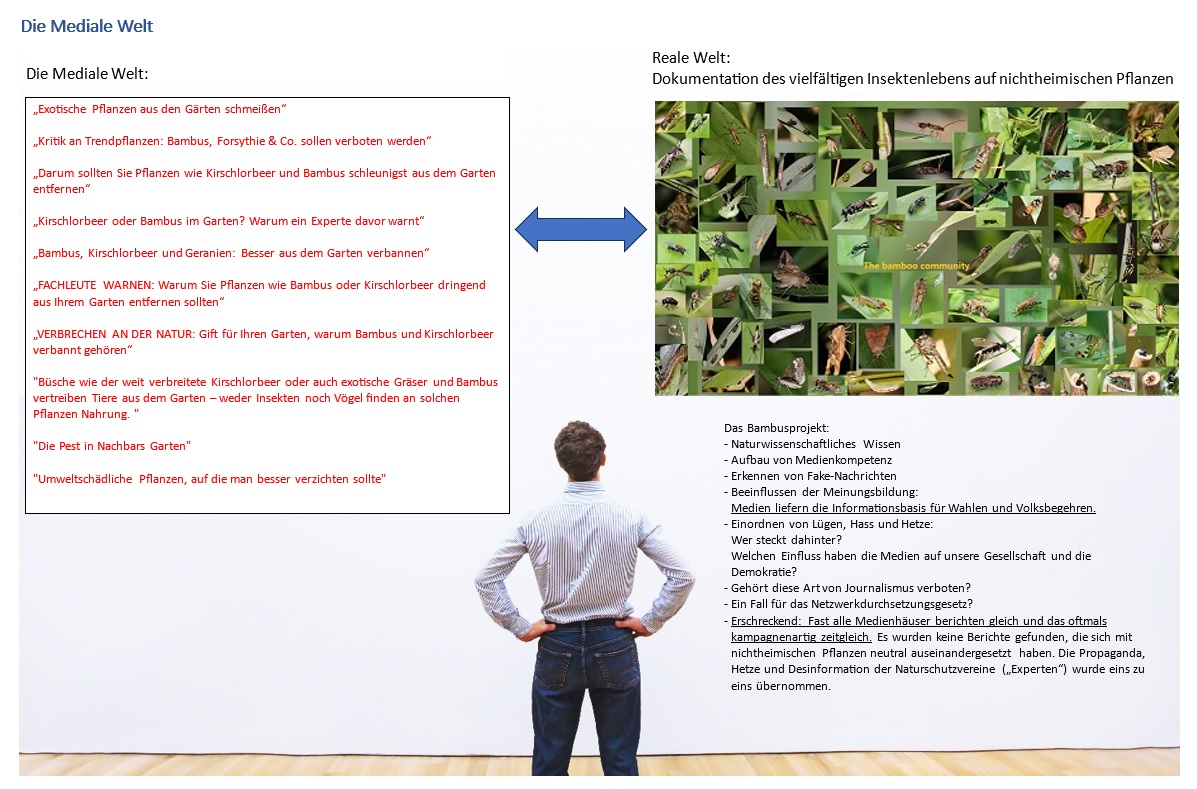Documentaries, Reportages and Background Reports
The
Gusovius bamboo project brings together the results of the insect study and
those of the media analysis. People are shown what untruths are
spread by nature conservation associations, "scientists", the media
and public broadcasting, and how these untruths affect legislation. The
Gusovius bamboo project is a combination of a traveling exhibition and a bamboo
park.
The Travelling
Exhibition
In the
prepared travelling exhibition, the media world and the world of scientific
reality are presented side by side. On the one hand, this is done through
quotations from the media and, on the other hand, through large-format posters
of the images of the scientific documentation. The travelling exhibition is
intended to reach as many people as possible and to overcome the botanical
xenophobia that has been imprinted in society so far.
A unique culture project, combined with a unique insect study and a unique media analysis, shows the dangers of spreading scientific misinformation.
On the
one hand, the viewer gains an insight into the fascinating life of insects on
non-native plants, and on the other hand, his media competence grows enormously
through the fact that he has to recognize how much untruth is being spread. The
exhibition also encourages curiosity to do one's own research and not to
believe everything that the media disseminates.
The
Bamboo Park
The
travelling exhibition can only be an introduction to overcoming xenophobia in
the field of the plant world. It is equally important that people can
experience the value of foreign plants with all their senses.
By
chance, the bamboo Fargesia nitida flowered and sowed itself in the private
garden of Gusovius more than ten years ago. This plant only blooms at intervals
of about 120 years and this worldwide. After flowering, the mother plant dies.
Numerous seedlings were obtained, and a small bamboo nursery was established.
Bamboo,
along with cherry laurel, thuja and forsythia, is one of the most rejected or
downright hated plants by many "conservationists", as the epitome of
the worthless foreign. Expressions such as "worthless than a concrete
wall", "ecological plague", "plastic plant" and
"crime against nature" are common in nature conservation circles and
even find their way into politics and, subsequently, legislation.
This
agitation and the associated stigmatization as the person responsible for
insect mortality gave the impetus to record the insect world in the bamboo
garden at home and to document it in pictures and films. In over five and a
half years, hundreds of thousands of recordings were taken.
A bamboo
park is planned. This is to be supplemented with numerous non-native plants and
preserved structures that are conducive to insects. Visitors can experience the
diverse insect life on site. Insect hotels can also be planted.
It is
time for an educational offensive that conveys to people the value of
non-native plants. The bamboo park will become a hotspot of biodiversity and a
source of knowledge for the whole of Europe.
Both
locals and people from different countries visit the bamboo park and enjoy the
botanical diversity and numerous insects.
The
Bamboo Park: An international meeting place against xenophobia.
